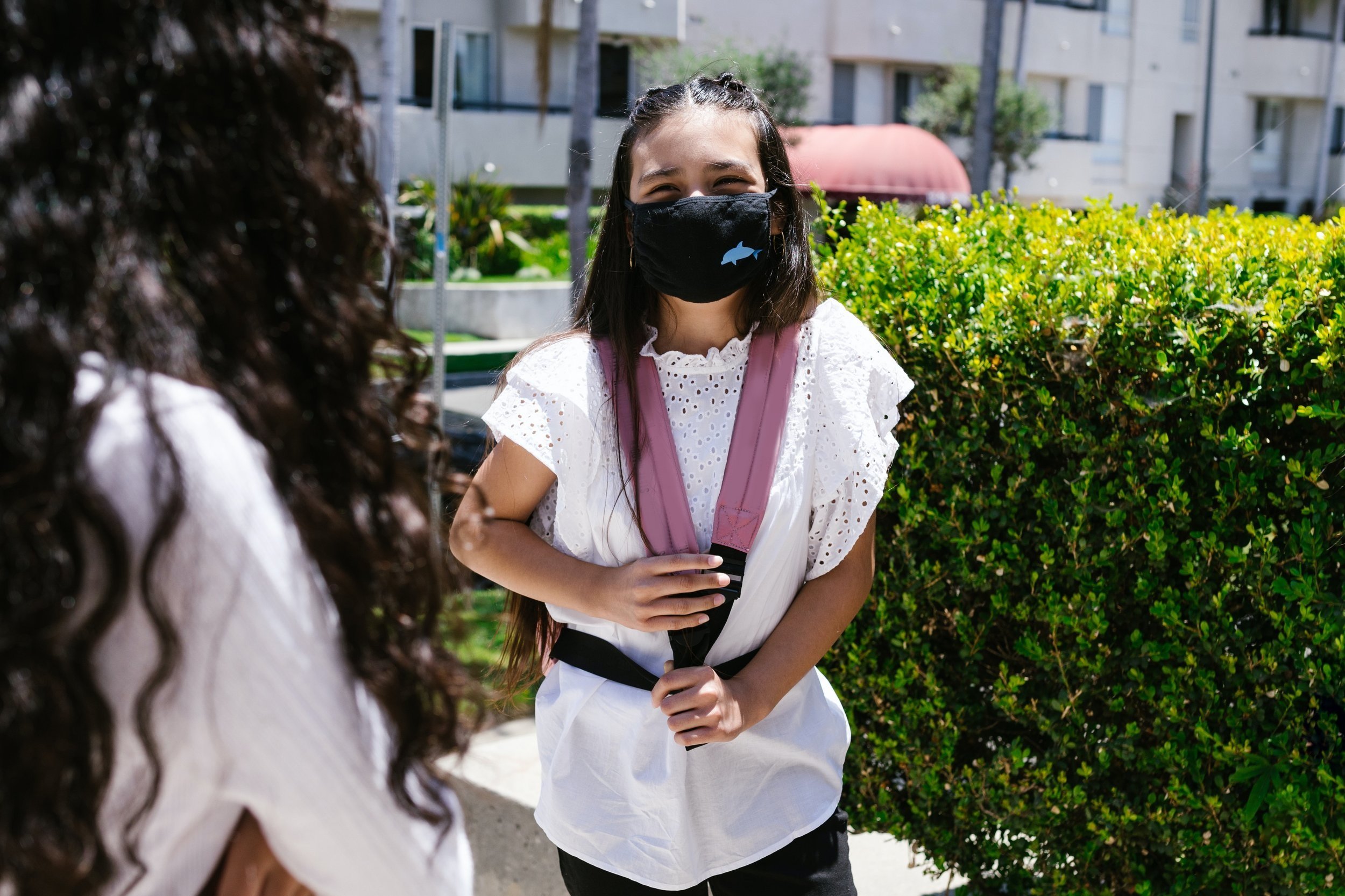Be Still My Heart; My Kids Are at School
By Laura Spiegel

Be still my heart; my kids are at school.
This morning, for the first time since March, my son and daughter scampered out of my car, backpacks swinging from their shoulders, and walked into a building they once knew like the back of their hands.
This is the fifth building my daughter has been inside in half a year. She has cystic fibrosis, and our family’s approach to the COVID-19 pandemic has been one of caution.
And yet, there she went. Masked up, water bottle in hand, her brother by her side.
I have to admit that when our school system announced this summer that the first four weeks of school would be done virtually, I breathed a sigh of relief. The decision was made for me, which meant I was exempt from my usual practice of thinking and overthinking and rethinking decisions related to my daughter’s health.
Four weeks ago, I took photos of my kids on their first day of virtual school. I chuckled as they sprinted toward the bus stop “for old time’s sake” before heading into the house. Our dining room table had once again been relegated to a desk. Folders were stacked, pencils were sharpened, and the iPads were freshly charged.
Thirty seconds in, my son “accidentally” deployed a spritz of bottled fart (yes, this actually exists, and yes, I actually let him buy it from Amazon). It lived up to its slogan and cleared the room in under a minute.
Day two of virtual learning was considerably better scented. But it quickly became clear that my kids could not sit across the table from one another. At all. For even one class.
And hence was born a magical “virtual learning space.” A place where my daughter could learn in the comfort of her own room, surrounded by butterflies. Witch costume optional.
My daughter showed up to her first Morning Circle on Zoom ten minutes early. By the following week, I was pulling her from bed at 8:58 and plopping her in front of the screen at 9:00. Efficient, right?
Zoom meeting done, she’d possibly proceed to the rest of her work. Or she’d take a 10-hour break and pick up again after dark. On these days, I had two things about which to harass her. Did she want to do school? Or did she want to do respiratory therapy?
The answer was always “None of the above.”
My son fared considerably better. He liked to complete his work in order and on time. But woe be the child who asks his mom for help. The conversation is bound to end in some variation of “So you’re telling me I’m dumb? Ugh. Why did I even ask you?”
As the fourth week of virtual learning dawned, I began to realize that for my family, this situation was not sustainable. It wasn’t anyone’s fault. The school system and the teachers truly exceeded my expectations. And my kids were trying their best in yet another situation that differed from the norm.
It just wasn’t working for us.
And so, we began to utter the seven words we’d previously dared not speak. Should we send them back to school?
Sometimes, the answers we need walk into our lives at just the right time. Mine came in the form of a national Town Hall hosted by the Cystic Fibrosis Foundation. It featured a panel of experts who came together to discuss the risks and benefits of returning to school with cystic fibrosis. It also provided factors for families to consider when deciding whether virtual or in-person learning is best for our kids.
One of my biggest takeaways from this group of CF physicians, school teachers, and parents is that there is no one right answer. So many circumstances impact what type of learning is best for a child or family. Things like:
Does my child have access to a safe learning environment at home?
How well is my child able to learn in a virtual setting?
How is my child currently doing socially and emotionally?
What is my child’s overall health today?
What is the level of COVID-19 spread in my community?
Am I comfortable with the school’s plan to protect my child’s health and safety in the classroom, at lunch, and at recess?
How well can my child effectively adhere to the school’s rules? (e.g. wearing a mask, social distancing, etc.)
What support does my child have from an Individualized Education Plan (IEP) or 504 plan perspective?
The Town Hall also reminded me that rarely ever do our decisions come without risk. It’s hard to eliminate risk entirely. But we can take proactive steps to mitigate it. And as with all risk mitigation plans, it’s important to have a plan B in place.
I found this Town Hall to be really informative. If you’re still on the fence about how to proceed with your child’s schooling, feel free to listen to a recording of it here. While much of it is specific to cystic fibrosis, the above considerations are not.
Last week, I walked my daughter’s teacher through her updated 504 plan and health plan. Many of the precautions that we’d historically taken are now standard practice. No more water fountains. Desks are disinfected daily. No communal school supplies. And so on.
And as I do every year, I asked the teacher to send a communication on my behalf to the other parents in my daughter’s classroom. This simple letter answers questions about CF and includes an “ask” for how parents can help my daughter have a healthy and happy year. If you’d like to do something similar for your child, feel free to download my letter and customize it for your own needs.
This morning, I talked to my kids about the importance of wearing their masks and washing their hands. I helped them label all their supplies and made them a big breakfast. And I sent them off.
It’s 11:45, and my kids are now two hours into their first in-person day of school. Am I cool as a cucumber? No. Am I on pins and needles? No. I guess I’m somewhere in between.
And so I will keep on communicating with the school and with my daughter’s care team. I will continue to assess the above considerations through the lens of my family, our school, and our town. And I will do everything I can to help my kids have a happy and healthy year.
After all, isn’t that all any of us can do?

